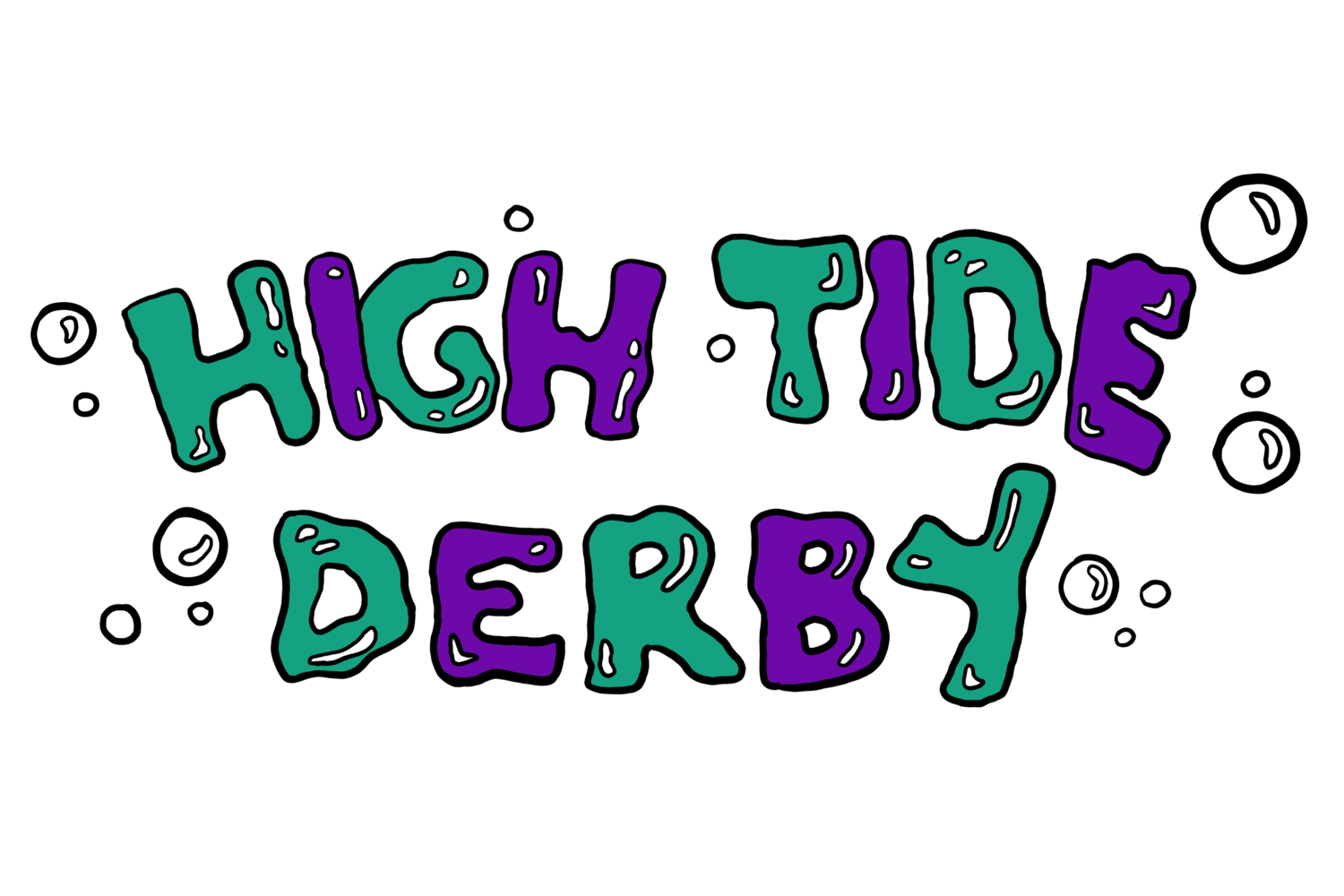Minimum Skills
Before participating in a scrimmage or bout, each skater must pass their Minimum Skills. High Tide encourages everyone to learn at their own pace, skills are assessed several times throughout the year. Skaters do not have to have any of these skills handled before skating with us. We go over basic skills each practice!
Basic Skating Skills - Level 1 Siren
Posture:
Skater bends at the knees with hips and shoulders back, shows stability with center of gravity down and forward, and skates low with bent, flexible knees.
Stride:
Skater uses strong, steady, confident strides. Both feet are used to push forward on straightaways and weight is shifted from foot to foot without stumbling. Skater must be able to do this while maintaining skate awareness, looking backward, forward, and to the sides with no issue.
Crossovers:
Skater performs smooth crossovers in straightaways & track turns. Skates a diamond pattern around the track and uses the inside foot to sweep under the outside to provide power to the stride.
T-Stops:
Skater maintains derby stance and balance while using all four wheels of the stopping skate to bring themselves to a controlled stop in a "T" format. Stop must be completed within three seconds. For a "satisfactory" score, skater only needs to accomplish this on one foot.
Plows:
Skater uses both legs to perform a low, controlled stop, with feet angled inward and power coming from the inside of the stance pushing outward. Stop must be completed within three seconds.
Balance:
Skater must be able to balance on one foot for the length of the track straightaway without losing footing or falling. For an "excellent" score, skaters must be able to do this on both feet.
Standing and Stepping:
Skaters must be able to maintain balance while standing on all four wheels, without sliding or slipping. They should be able to shuffle in both directions with a sense of urgency and purpose, eyes trained ahead and not down at their feet.
Falling:
Skater must be able to safely complete a four-point fall and return to skating speed within just a few seconds after assessing safety to stand and resume skating.
Pacing:
Skater must be able to adjust to the variable speeds of a pace line, keeping an arms-length distance from other skaters without falling, tripping, overtaking or running into another skater.
Transitions:
Skater can complete a 180 degree turn without breaking stride, ending in a stop, backwards skating, and a 360 degree turn. For a "satisfactory," skaters must complete a transition in one direction.
Backwards Skating:
Skaters must be able to complete at least two laps backwards, demonstrating the ability to change trajectory, maneuver, and adjust their speed while maintaining track awareness.
Contact Skills - Level 2 Siren
Endurance:
Skaters must complete 1 lap in 13 seconds, then 11 laps in 2 minutes, followed by 2 minutes of active and competitive engagement with a 4-skater pack.
Transitions:
Skater can complete a 180 degree turn without breaking stride, ending in a stop, backwards skating, and a 360 degree turn. For a "satisfactory," skaters must complete a transition in both directions.
Backwards Skating:
Skaters must be able to complete at least four laps backwards, demonstrating the ability to change trajectory, maneuver, and adjust their speed while maintaining track awareness.
Knee Taps and Slides:
Skaters must be able to perform knee taps on both sides without losing their momentum or balance, recovering without needing their hands to get up. For a double knee slide, skaters must recover without significant interruption to their pace.
Toe Stops:
Skaters should show control on their toe stops, maintaining balance and bouncing in place without much trouble. For an "satisfactory" in this category, skaters should be able to use their toe stops to begin a stride or a run, with several uninterrupted steps required for an "excellent."
Jumping:
Skaters must be able to jump or hop forward and laterally without losing their balance, over at least a 6" tall obstacle.
Weaving:
Skaters must be able to weave and maneuver at a relatively brisk pace through both a set of at least ten cones into a turn AND a moderately-paced pace line of moving skaters.
Pushing:
Skaters should be able to push a receiving skater near their center of gravity with ample force to noticeably change their direction of momentum. Skaters must also use momentum from a forward push to accelerate their own pace.
Pack Skating and Communication:
Skaters must demonstrate communication with surrounding skaters during a pace line and during pack skating to alert them to incoming jammers, looking continually and using a loud, clear voice. In a pack of 4-10 moving at a moderate pace, skaters must demonstrate the ability to perform safe knee taps and slides at unexpected times in the pack. Pack skaters must avoid the downed skaters without going out of bounds, falling over them or causing unnecessary hazard.
Checking:
Skaters must perform repetitive hip and body checks delivered with legal blocking/target zones while skating at a brisk pace.
Taking Hits:
Skater responds safely to repeated heavy blocks without flailing or grabbing other skaters. If the hit knocks the skater off balance, they fall safely without sprawling and recover within 2-4 seconds.
Positional Blocking:
Skaters must demonstrate the ability to lean and push on an opponent with legal blocking zones to legal target zones while moving at moderate pack speed. Skaters must also plow within the confines of the pack to slow a targeted skater without tripping other skaters.
